Historical Overview: Feminism Movements in United States
VerifiedAdded on 2022/08/11
|6
|1041
|28
Essay
AI Summary
This essay provides a comprehensive overview of the feminism movements in the United States, tracing the evolution of feminist thought and activism across different waves. It begins by examining the women's suffrage movement (1848-1920), detailing its agenda, strategies, and the major split caused by disagreements over property rights. The essay then explores the women's liberation movement (1960s-1970s), discussing its goals, the challenges it faced, and the splits that emerged due to differences in age, class, and ethnicity. It also highlights external factors that disrupted these movements, such as opposition from the German American community and southern cotton mills. The essay further delves into the third wave of feminism (1990-2010), its focus on individualism and diversity, and the distinction between liberal and radical feminism, including their historical roots and critiques. References from various academic sources are included to support the analysis.
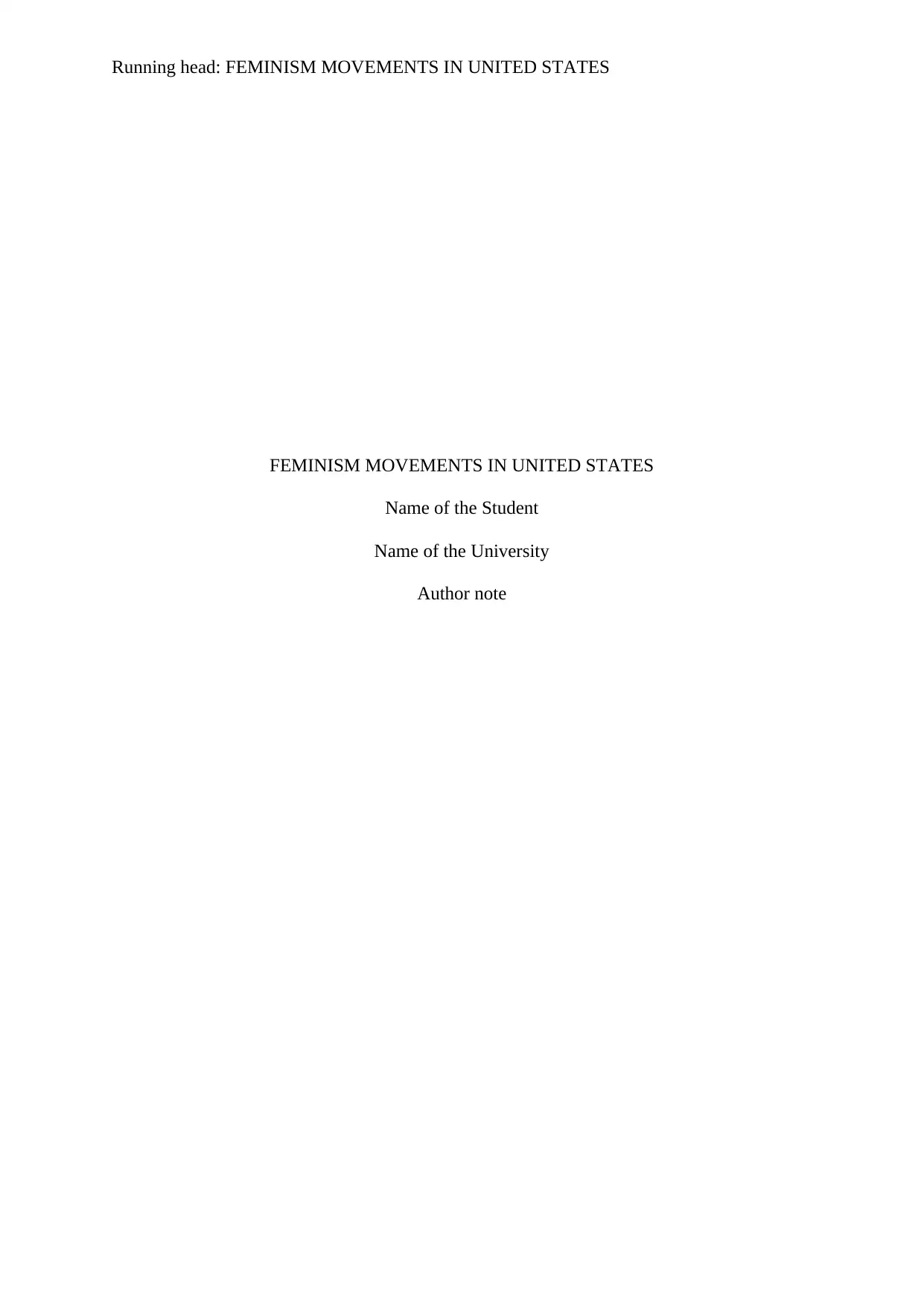
Running head: FEMINISM MOVEMENTS IN UNITED STATES
FEMINISM MOVEMENTS IN UNITED STATES
Name of the Student
Name of the University
Author note
FEMINISM MOVEMENTS IN UNITED STATES
Name of the Student
Name of the University
Author note
Paraphrase This Document
Need a fresh take? Get an instant paraphrase of this document with our AI Paraphraser
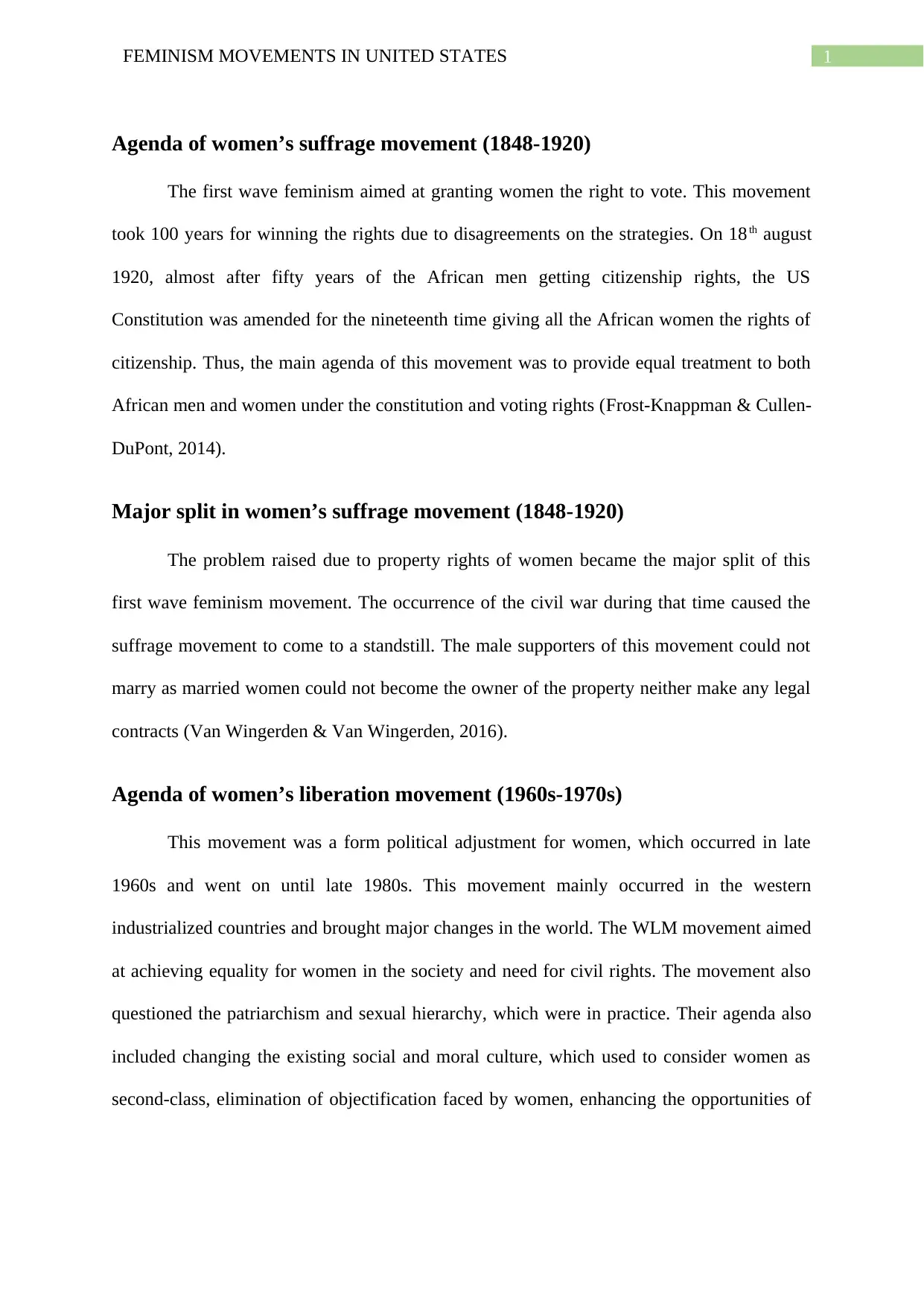
1FEMINISM MOVEMENTS IN UNITED STATES
Agenda of women’s suffrage movement (1848-1920)
The first wave feminism aimed at granting women the right to vote. This movement
took 100 years for winning the rights due to disagreements on the strategies. On 18th august
1920, almost after fifty years of the African men getting citizenship rights, the US
Constitution was amended for the nineteenth time giving all the African women the rights of
citizenship. Thus, the main agenda of this movement was to provide equal treatment to both
African men and women under the constitution and voting rights (Frost-Knappman & Cullen-
DuPont, 2014).
Major split in women’s suffrage movement (1848-1920)
The problem raised due to property rights of women became the major split of this
first wave feminism movement. The occurrence of the civil war during that time caused the
suffrage movement to come to a standstill. The male supporters of this movement could not
marry as married women could not become the owner of the property neither make any legal
contracts (Van Wingerden & Van Wingerden, 2016).
Agenda of women’s liberation movement (1960s-1970s)
This movement was a form political adjustment for women, which occurred in late
1960s and went on until late 1980s. This movement mainly occurred in the western
industrialized countries and brought major changes in the world. The WLM movement aimed
at achieving equality for women in the society and need for civil rights. The movement also
questioned the patriarchism and sexual hierarchy, which were in practice. Their agenda also
included changing the existing social and moral culture, which used to consider women as
second-class, elimination of objectification faced by women, enhancing the opportunities of
Agenda of women’s suffrage movement (1848-1920)
The first wave feminism aimed at granting women the right to vote. This movement
took 100 years for winning the rights due to disagreements on the strategies. On 18th august
1920, almost after fifty years of the African men getting citizenship rights, the US
Constitution was amended for the nineteenth time giving all the African women the rights of
citizenship. Thus, the main agenda of this movement was to provide equal treatment to both
African men and women under the constitution and voting rights (Frost-Knappman & Cullen-
DuPont, 2014).
Major split in women’s suffrage movement (1848-1920)
The problem raised due to property rights of women became the major split of this
first wave feminism movement. The occurrence of the civil war during that time caused the
suffrage movement to come to a standstill. The male supporters of this movement could not
marry as married women could not become the owner of the property neither make any legal
contracts (Van Wingerden & Van Wingerden, 2016).
Agenda of women’s liberation movement (1960s-1970s)
This movement was a form political adjustment for women, which occurred in late
1960s and went on until late 1980s. This movement mainly occurred in the western
industrialized countries and brought major changes in the world. The WLM movement aimed
at achieving equality for women in the society and need for civil rights. The movement also
questioned the patriarchism and sexual hierarchy, which were in practice. Their agenda also
included changing the existing social and moral culture, which used to consider women as
second-class, elimination of objectification faced by women, enhancing the opportunities of
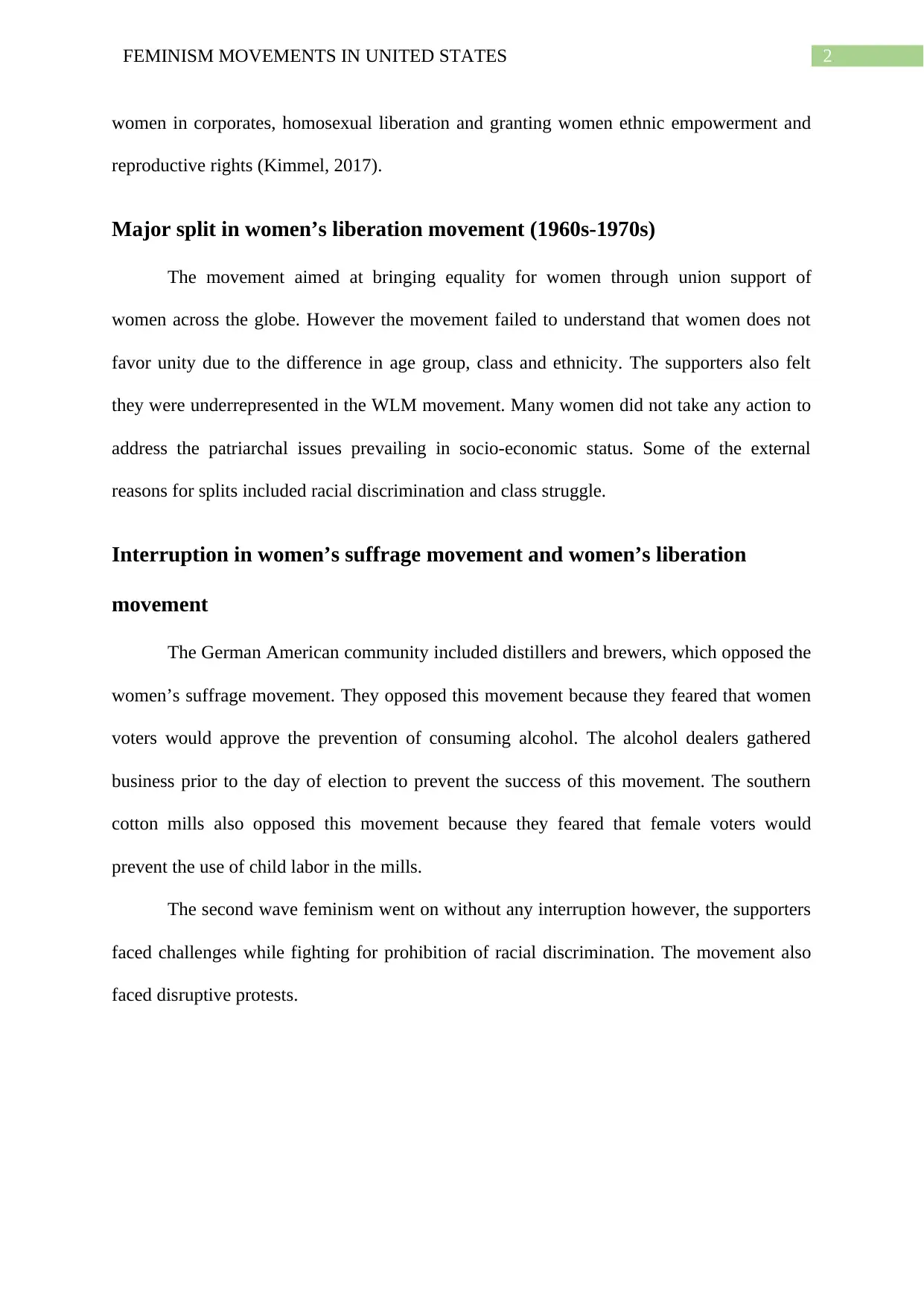
2FEMINISM MOVEMENTS IN UNITED STATES
women in corporates, homosexual liberation and granting women ethnic empowerment and
reproductive rights (Kimmel, 2017).
Major split in women’s liberation movement (1960s-1970s)
The movement aimed at bringing equality for women through union support of
women across the globe. However the movement failed to understand that women does not
favor unity due to the difference in age group, class and ethnicity. The supporters also felt
they were underrepresented in the WLM movement. Many women did not take any action to
address the patriarchal issues prevailing in socio-economic status. Some of the external
reasons for splits included racial discrimination and class struggle.
Interruption in women’s suffrage movement and women’s liberation
movement
The German American community included distillers and brewers, which opposed the
women’s suffrage movement. They opposed this movement because they feared that women
voters would approve the prevention of consuming alcohol. The alcohol dealers gathered
business prior to the day of election to prevent the success of this movement. The southern
cotton mills also opposed this movement because they feared that female voters would
prevent the use of child labor in the mills.
The second wave feminism went on without any interruption however, the supporters
faced challenges while fighting for prohibition of racial discrimination. The movement also
faced disruptive protests.
women in corporates, homosexual liberation and granting women ethnic empowerment and
reproductive rights (Kimmel, 2017).
Major split in women’s liberation movement (1960s-1970s)
The movement aimed at bringing equality for women through union support of
women across the globe. However the movement failed to understand that women does not
favor unity due to the difference in age group, class and ethnicity. The supporters also felt
they were underrepresented in the WLM movement. Many women did not take any action to
address the patriarchal issues prevailing in socio-economic status. Some of the external
reasons for splits included racial discrimination and class struggle.
Interruption in women’s suffrage movement and women’s liberation
movement
The German American community included distillers and brewers, which opposed the
women’s suffrage movement. They opposed this movement because they feared that women
voters would approve the prevention of consuming alcohol. The alcohol dealers gathered
business prior to the day of election to prevent the success of this movement. The southern
cotton mills also opposed this movement because they feared that female voters would
prevent the use of child labor in the mills.
The second wave feminism went on without any interruption however, the supporters
faced challenges while fighting for prohibition of racial discrimination. The movement also
faced disruptive protests.
⊘ This is a preview!⊘
Do you want full access?
Subscribe today to unlock all pages.

Trusted by 1+ million students worldwide
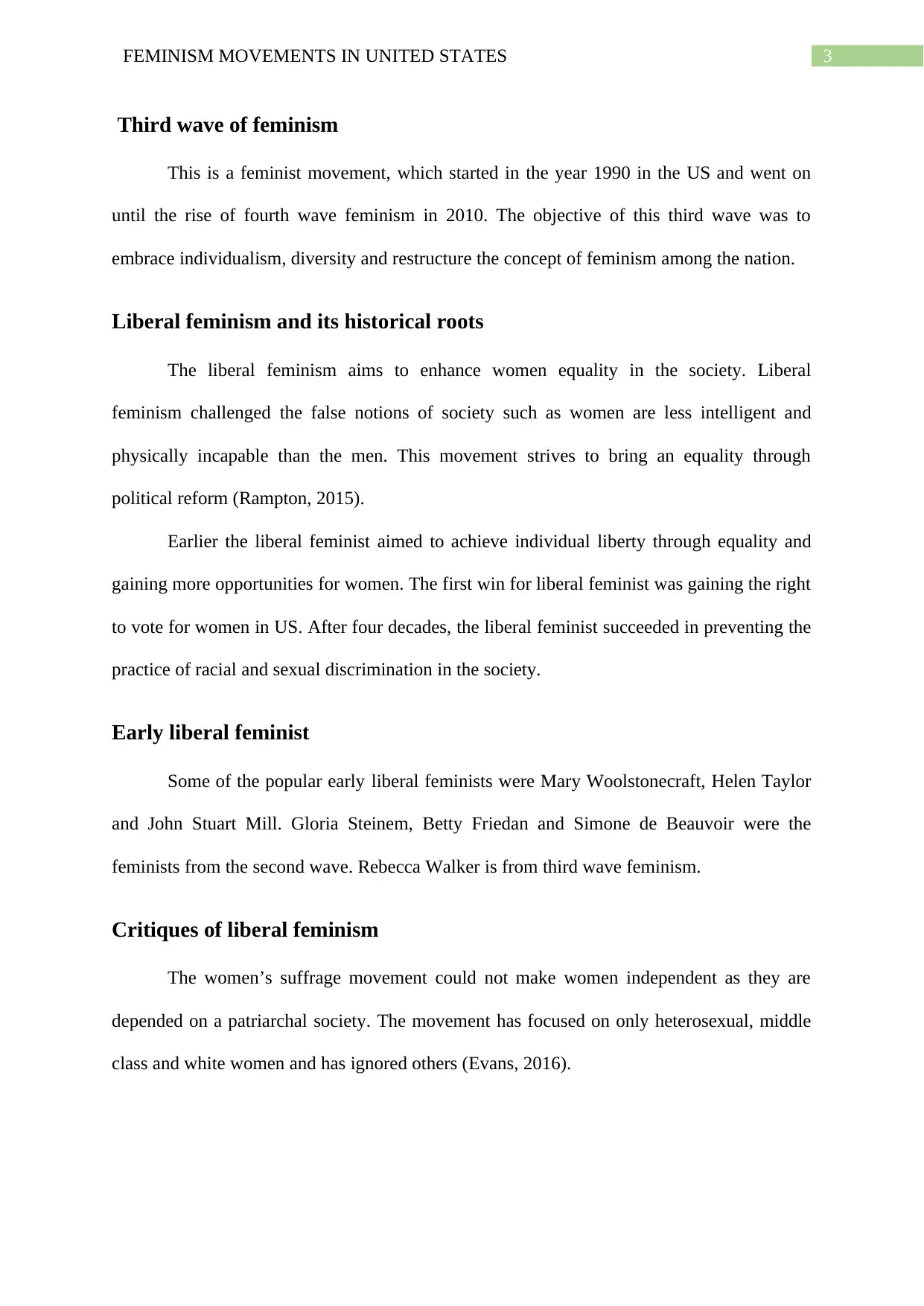
3FEMINISM MOVEMENTS IN UNITED STATES
Third wave of feminism
This is a feminist movement, which started in the year 1990 in the US and went on
until the rise of fourth wave feminism in 2010. The objective of this third wave was to
embrace individualism, diversity and restructure the concept of feminism among the nation.
Liberal feminism and its historical roots
The liberal feminism aims to enhance women equality in the society. Liberal
feminism challenged the false notions of society such as women are less intelligent and
physically incapable than the men. This movement strives to bring an equality through
political reform (Rampton, 2015).
Earlier the liberal feminist aimed to achieve individual liberty through equality and
gaining more opportunities for women. The first win for liberal feminist was gaining the right
to vote for women in US. After four decades, the liberal feminist succeeded in preventing the
practice of racial and sexual discrimination in the society.
Early liberal feminist
Some of the popular early liberal feminists were Mary Woolstonecraft, Helen Taylor
and John Stuart Mill. Gloria Steinem, Betty Friedan and Simone de Beauvoir were the
feminists from the second wave. Rebecca Walker is from third wave feminism.
Critiques of liberal feminism
The women’s suffrage movement could not make women independent as they are
depended on a patriarchal society. The movement has focused on only heterosexual, middle
class and white women and has ignored others (Evans, 2016).
Third wave of feminism
This is a feminist movement, which started in the year 1990 in the US and went on
until the rise of fourth wave feminism in 2010. The objective of this third wave was to
embrace individualism, diversity and restructure the concept of feminism among the nation.
Liberal feminism and its historical roots
The liberal feminism aims to enhance women equality in the society. Liberal
feminism challenged the false notions of society such as women are less intelligent and
physically incapable than the men. This movement strives to bring an equality through
political reform (Rampton, 2015).
Earlier the liberal feminist aimed to achieve individual liberty through equality and
gaining more opportunities for women. The first win for liberal feminist was gaining the right
to vote for women in US. After four decades, the liberal feminist succeeded in preventing the
practice of racial and sexual discrimination in the society.
Early liberal feminist
Some of the popular early liberal feminists were Mary Woolstonecraft, Helen Taylor
and John Stuart Mill. Gloria Steinem, Betty Friedan and Simone de Beauvoir were the
feminists from the second wave. Rebecca Walker is from third wave feminism.
Critiques of liberal feminism
The women’s suffrage movement could not make women independent as they are
depended on a patriarchal society. The movement has focused on only heterosexual, middle
class and white women and has ignored others (Evans, 2016).
Paraphrase This Document
Need a fresh take? Get an instant paraphrase of this document with our AI Paraphraser
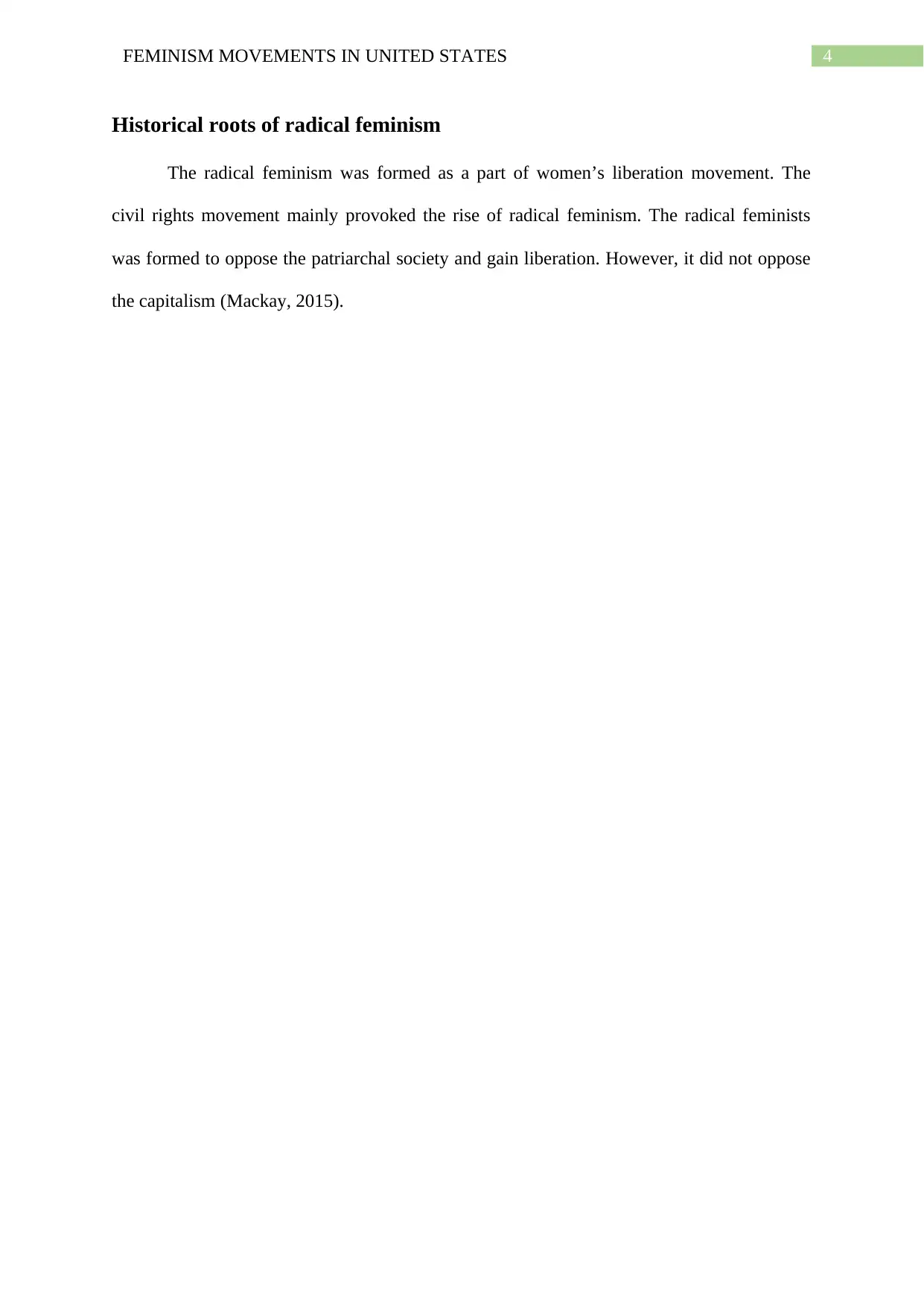
4FEMINISM MOVEMENTS IN UNITED STATES
Historical roots of radical feminism
The radical feminism was formed as a part of women’s liberation movement. The
civil rights movement mainly provoked the rise of radical feminism. The radical feminists
was formed to oppose the patriarchal society and gain liberation. However, it did not oppose
the capitalism (Mackay, 2015).
Historical roots of radical feminism
The radical feminism was formed as a part of women’s liberation movement. The
civil rights movement mainly provoked the rise of radical feminism. The radical feminists
was formed to oppose the patriarchal society and gain liberation. However, it did not oppose
the capitalism (Mackay, 2015).
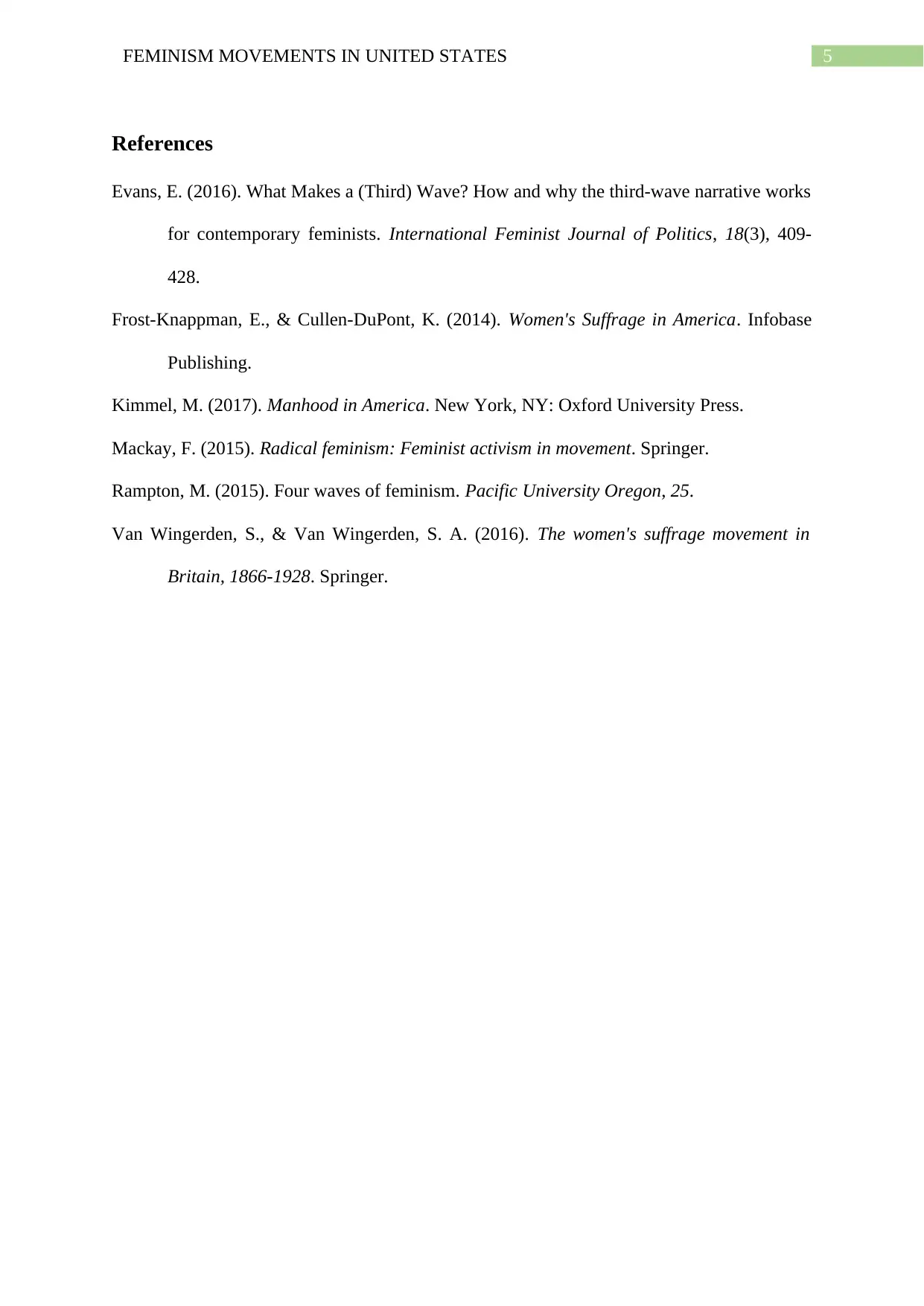
5FEMINISM MOVEMENTS IN UNITED STATES
References
Evans, E. (2016). What Makes a (Third) Wave? How and why the third-wave narrative works
for contemporary feminists. International Feminist Journal of Politics, 18(3), 409-
428.
Frost-Knappman, E., & Cullen-DuPont, K. (2014). Women's Suffrage in America. Infobase
Publishing.
Kimmel, M. (2017). Manhood in America. New York, NY: Oxford University Press.
Mackay, F. (2015). Radical feminism: Feminist activism in movement. Springer.
Rampton, M. (2015). Four waves of feminism. Pacific University Oregon, 25.
Van Wingerden, S., & Van Wingerden, S. A. (2016). The women's suffrage movement in
Britain, 1866-1928. Springer.
References
Evans, E. (2016). What Makes a (Third) Wave? How and why the third-wave narrative works
for contemporary feminists. International Feminist Journal of Politics, 18(3), 409-
428.
Frost-Knappman, E., & Cullen-DuPont, K. (2014). Women's Suffrage in America. Infobase
Publishing.
Kimmel, M. (2017). Manhood in America. New York, NY: Oxford University Press.
Mackay, F. (2015). Radical feminism: Feminist activism in movement. Springer.
Rampton, M. (2015). Four waves of feminism. Pacific University Oregon, 25.
Van Wingerden, S., & Van Wingerden, S. A. (2016). The women's suffrage movement in
Britain, 1866-1928. Springer.
⊘ This is a preview!⊘
Do you want full access?
Subscribe today to unlock all pages.

Trusted by 1+ million students worldwide
1 out of 6
Your All-in-One AI-Powered Toolkit for Academic Success.
+13062052269
info@desklib.com
Available 24*7 on WhatsApp / Email
![[object Object]](/_next/static/media/star-bottom.7253800d.svg)
Unlock your academic potential
Copyright © 2020–2025 A2Z Services. All Rights Reserved. Developed and managed by ZUCOL.


